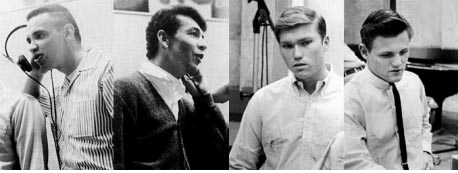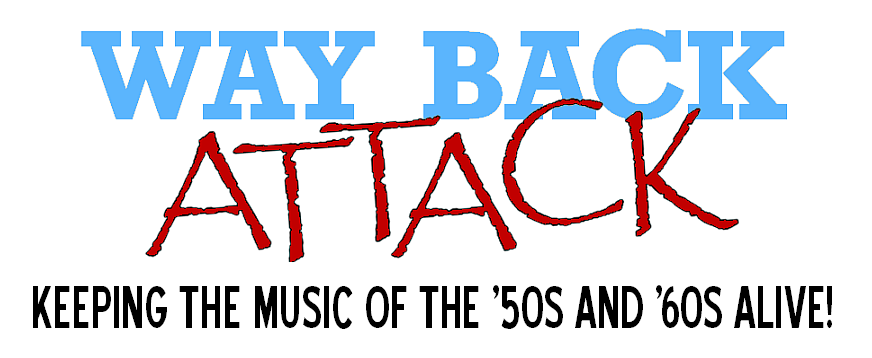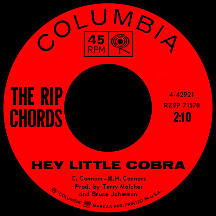THE RIP CHORDS
Hey Little Cobra
Two guys from Inglewood, fresh out of high school, musically-inclined and fans of the era's rock and doo wop sounds, decided around 1957 to start a two-man band. High-voiced Ernie Bringas and deeper-toned Phil Stewart called themselves The Opposites, made a demo record, sent copies to labels large and small, and experienced the depths of rejection...a few year's worth. Finally, in 1962, an opportunity came at Columbia (the nation's largest record company, no less), where they met Terry Day, who with the help of his mother Doris had gotten in the door and released a couple of teen-style singles ("That's All I Want" and Crystals cover/answer song "I Love You, Betty") before focusing on production and songwriting using his given name, Terry Melcher. Inspired by Ripcord, an action-packed syndicated ZIV-TV series about skydivers, the Opposites became The Rip Chords. "Here I Stand," a remake of Wade Flemons' wonderfully yearning '59 hit, was arranged with a sad-but-sunny, doo woppin' Cali sound; Ernie and Phil made several personal appearances promoting the song as it inhabited the national charts from March 'til May 1963.
Terry brought in his pal Bruce Johnston, who'd already made records for the Ronda label ("Do the Surfer Stomp," a simple dance ditty in two parts) and Bob Keane's Donna Records (a cringy Soupy Sales knockoff, "Soupy Shuffle Stomp"). They dipped their pedal-accelerating toes into the hot rod genre with a breakup song (penned by Johnston and Melcher), "Gone" (cue the super-stock sound-effect intro: the girl says "Bye-bye" and speeds off), two infectious minutes of wailing 'She's gone, gone, gone...' by the Rip Chords-plus-one; Bruce provided the song's unhinged falsetto vocals. It rode the low end of the charts in August and September '63. To Terry, this was just one of many such surf-and-sand and/or tricked-out-car-related projects; Bruce went off and made "Pajama Party" for Del-Fi and with studio musicians the two put out an album on Epic as The Hot Doggers, Surfin' U.S.A., covering the biggest surf vocals and instrumentals (by The Beach Boys, The Marketts, Dick Dale and others) of the previous 18 months. A third Rip Chords release was also in the works.
Car-obsessed Texan Carroll Hall Shelby had won a series of races during the '50s including his coveted first place finish in the 1959 round of France's "world endurance" event, 24 Hours of LeMans (giving the makers of Britain's Aston Martin their first and only victory). Over the next few years, he developed the Shelby Cobra for the Ford Motor Company, a popular V-8 introduced in 1962 that competed successfully in the U.S. with Chevrolet's Corvette and in Europe with Italy's super-speedy Ferrari. Songs about fast cars were popular in the early 1960s including "Hot Rod Lincoln," a hit for both Charlie Ryan and Johnny Bond, "Jaguar and Thunderbird" by Chuck Berry, the Beach Boys' "409" and "Little Deuce Coupe" and The Routers' "Sting Ray." Songwriter Carol Connors (born Annette Kleinbard, she had sung lead on The Teddy Bears' 1958 chart-topper "To Know Him is to Love Him") claimed Shelby promised to give her a Cobra if she wrote a hit song about his car, so with her brother, Marshall Kleinbard (using the psudonym M.H. Connor), she did just that. The Rip Chords were on the verge of having one of the hottest revved-up hits of all - not necessarily the direction Ernie and Phil had envisioned for themselves!
Ernie Bringas, however, was torn between his religious studies and rising rock and roll career. In mid-1963, after a few Rip Chords appearances in the L.A. and San Francisco areas, he entered a seminary in Dayton, Ohio for training as a Methodist minister. Suddenly Phil Stewart stood alone, the only official member of a band signed to a major label. Connors' "Hey Little Cobra" was recorded in the fall of '63 with Terry Melcher taking the lead vocal, accompanied by Johnston and Stewart with backing from many of L.A.'s top session musicians (referred to years later as "The Wrecking Crew"). In early 1964, the single that glorified Ford's sporty Cobra spent six weeks in Billboard's top ten, getting as high as number four just as Beatlemania was taking hold. Carroll Shelby made good on his promise to songwriter Carol Connors; afterwards, she was often spotted driving around Hollywood in her new Cobra (hopefully she let Marshall take the wheel once in awhile). Touring was the next step, but Terry and Bruce had too much going on to be able to fill that need. Rich Rotkin and Arnie Marcus (members of late '50s group The Upperclassmen) were hired to back Phil vocally in concert, though they never participated in the studio recordings.

Within days of the "Hey Little Cobra" session, Johnston and Melcher made a similar recording, "Custom Machine." Credited to Bruce and Terry, it spent a few weeks on the charts while "Cobra" cruised the upper tier. During a holiday break from seminary, Ernie participated in the recording of the album Hey Little Cobra and Other Hot Rod Hits, joining Phil, Terry and Bruce on vocals. The four recorded the next single, "Three Window Coupe" (written by Jan Berry and Roger Christian), which became a top 30 hit in June. Ernie left again, taking one final break in the spring to record the Three Window Coupe LP, after which he was no longer involved. Rich and Arnie continued touring with Phil as a trio, providing a public image at odds with the music's originators.
The Rip Chords went the beach route with the Don Altfield-Steve Barri-P.F. Sloan tune "One Piece Topless Bathing Suit," spoofing designer Rudi Gernreich's "shocking" swimwear sensation of '64 (the song's lyrics reveal the shameless beach girl was only four years old). Bruce and Terry's simultaneous release, "Summer Means Fun," bested the "Topless" track in August. Johnston and Melcher later issued singles as The Rogues (remakes of Buddy Holly's "Everyday" and Ritchie Valens' "Come On, Let's Go") in addition to a few more Bruce and Terry discs. The final Rip Chords single (with the group's name compressed to The Ripchords) came in early 1965; "Don't Be Scared" (borrowing a couple of melody lines from earlier Beach Boys hits) featured a lead vocal by Terry. The three also recorded "Red Hot Roadster," lip-synced by the Stewart-led touring trio in A Swingin' Summer, a spring '65 theatrical release.
Ernie Bringas had chosen his religion over a career in music. Phil Stewart found himself squeezed out with only occasional royalty checks coming in. Bruce Johnston joined the Beach Boys that spring, essentially as a replacement for Brian Wilson, who preferred studio work. Terry Melcher gave in to this same preference, becoming a full-time producer at Columbia, having successful results with The Byrds and Paul Revere and the Raiders, in addition to projects with dozens of other artists. He and Bruce duetted once again on a 1975 single for RCA, "Take it to Mexico (Tulsa County Blue)," and Terry produced a number of Brian-less Beach Boys recordings in the mid-to-late-'80s including the number one hit "Kokomo." During that time, Rich and Arnie resumed what they'd always done, only later tours featured no actual recorded group members (Ernie and Phil and/or Bruce and Terry). The Rip Chords themselves are simply an artifact of the 1960s...with a few dozen cool "California Sound" recordings as evidence of the group's existence.


